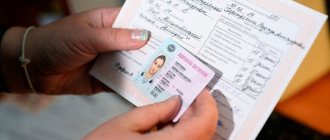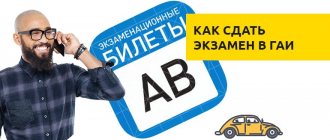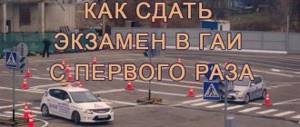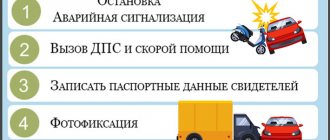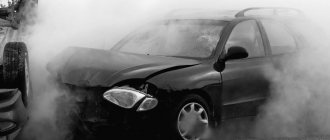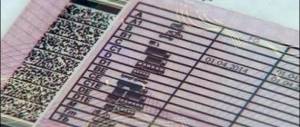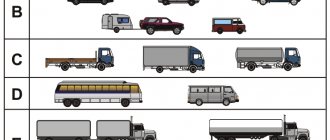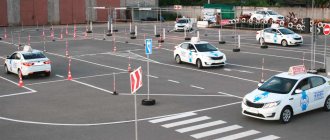AutoYurait.rf / Driver's license
Back
Published: 12/31/2018
Reading time: 5 min
0
1600
According to Russian laws, any driver driving on the roads must have an appropriate license. And it doesn’t matter how many wheels your vehicle has - four or just two. Relatively recently, the requirements for motorcycle and scooter drivers were more flexible. Since 2013, the situation has changed radically and even a scooter driver is required to undergo training at a motorcycle school.
- Motorcycle license: is it possible to do without them?
- At what age can you drive a motorcycle?
- What categories of motorcycle rights are allocated in 2021? Rights for a motorcycle with a sidecar
- Moped and scooter licenses
- Documents of the future driver
Motorcycle license: is it possible to do without them?
The law is adamant. If you are not going to sit behind the wheel of a bicycle forever, but plan to at least occasionally get behind the wheel of at least a moped, a license is required. And this is not a whim of traffic police inspectors and motorcycle schools who want to “extract” more money from you.
A qualified driver who has undergone training clearly knows how to behave in a given traffic situation. While the “disenfranchised” driver only guesses about the correctness of his behavior on the road. And it’s good if such driving only ends with a fine and confiscation of the two-wheeled horse.
Don’t even hope that the weak engine of your scooter will be a mitigating circumstance when meeting with traffic police officers. No one has canceled age restrictions either.
But owners of motocross motorcycles can breathe easy. They do not face fines or confiscation of the vehicle for driving without a license. But as long as they remain on the territory of sports tracks.
The reason for the “indulgence” is simple: a motocross motorcycle belongs to the category of sports equipment. And as long as its owner races on dirt tracks, he does not break any rules.
What will it be like to drive a motorcycle without a license?
Driving a motorcycle without papers confirming the subject's skill level is an administrative offense for which a fine of 5 to 15 thousand rubles is provided. The vehicle will be evacuated to the impound lot, and the owner will be able to pick it up from there only after presenting his license, or with a person who has a driver’s document of the required level.
At what age can you drive a motorcycle?
This parameter is directly related to the type of two-wheeled vehicle that the driver plans to drive. There are motorcycles that you can drive no earlier than 18 years old. But there are categories of vehicles available for driving from the age of 16.
| Scooters, mopeds | Engine capacity not exceeding 50 cubic meters | From 16 years old |
| Light motorcycles | Engine capacity up to 125 cc | From 16 years old |
| Motorcycles | Engine capacity is more than 125 cubic meters | From 18 years old |
| Tricycles, ATVs | Engine capacity from 50 cubic meters | From 18 years old |
More on the topic: Revocation of driver's license for debts
You are allowed to start learning how to operate a motorcycle long before your 18th birthday. But be patient, you will be allowed to take the exams only when you reach this age.
What category of license should you have to drive a motorcycle?
The law establishes category “A” for motorcycle licenses. Accordingly, only:
- Citizens (or residents) over 16 years of age.
- Recognized as mentally healthy.
- Passed a physical health test.
The type of A-license is related to the engine size of the vehicle. If it does not exceed 125 cubic meters, then the driver receives a certificate of form “A1”, and if it exceeds - form “A”.
Until 2013, licenses were not required for motorcycles with an engine size of up to 50cc. After changing the conditions, the question “for which motorcycles do you need a license” can be answered precisely - for everything, it’s just that vehicles on two (or three) wheels with small engines were called mopeds, and a separate category of rights was created for them - M.
But even to this rule there are exceptions. For example, a cross-country motorcycle or ATV, which is used for off-road travel outside the city limits, can be driven without obtaining a driver’s license.
Useful to know: “How to register a motorcycle and get license plates”
What categories of motorcycle licenses are there in 2018?
The motor market is ready to offer a huge selection of motorcycles. How not to get confused in this diversity and understand which category is needed to control a particular two-wheeled horse? The classification decided everything.
Since motorcycles are different, it was decided to distinguish three categories: “M”, “A”, “A1”. Each of them makes it possible to control motorcycles with different weights and engine sizes.
| Category “M” Appeared in 2013 | Engine capacity not exceeding 50 cubic meters | Mopeds (tricycles, scooters); quads; mokiki; scooters |
| Category “A1” (most common among teenagers) | engine capacity from 50 to 125 cubic meters; maximum power – up to 11 kW. | Light motorcycles |
| Category "A" | engine capacity up to 125 cubic meters; vehicle weight in running order up to 400 kg | Motorcycles |
If the future driver has already crossed the 18-year mark, it makes sense to study for category “A”. In this case, “M” and “A1” will be given to him as bonuses. The significant date is far away, but you really want to drive, choose “M” or “A1” - depending on your vehicle.
License for a motorcycle with a sidecar
Are you planning to buy a motorcycle with a sidecar? Hurry up to get your category “A” license. For your own safety, do not be lazy to take a couple of lessons on riding such a motorcycle.
This type of transport is fundamentally different from its two-wheeled counterpart. Because of the stroller on one side, it takes up much more space on the road. And this requires a special habit.
Moped and scooter licenses
The emergence of the “M” category has made life easier for owners of scooters and mopeds. Having reached 16 years of age, complete training at a motorcycle school and freely ride lightweight vehicles.
If the driver has been trained for category “A”, then “M” is entered automatically. What gives you the right to drive a light scooter.
Primary requirements
You can open category A at 18 years old, and categories A1 and M at 16 years old.
A younger student can enroll in a motorcycle school, but he will be allowed to take the exam after reaching 16 or 18 years of age. To obtain a driver's license, you must collect the following documents:
- passport (used to confirm identity, age and registration);
- medical report on health status;
- receipt of payment of state duty in the amount of 2 thousand rubles;
- photograph 3x4 cm (for making a device);
- certificate from a motorcycle school (if the institution does not take part in organizing the exam);
- previously obtained driving license (if the driver opens an additional category).
If an institution submits data to the state traffic inspectorate for its students, the listed papers must be provided to the office of the motorcycle school. If this service is not included in the cost of training, documents are provided to the MREO independently. The staff will accept the documents and set the exam date.
Driver requirements
- The future driver must be healthy; the appropriate certificate is obtained before the start of the training course. It would be a shame to take a course at a motorcycle school and find yourself unfit for health.
When undergoing a medical examination, warn the medical commission about your desire to open the “M” category. If you do not do this, the category will not appear in your rights. You will not be able to drive a moped.
- Reaching a certain age – each category has age parameters;
- Completion of training at a motorcycle school corresponding to the required category.
Training expenses
To obtain a certificate on the basis of which a person is given permission to drive 2-wheeled vehicles, you must contact a driving school. There you can find out how much it costs to get a motorcycle license. Moreover, the price of this service may vary depending on the level of qualifications of teachers, the cost of fuel and other factors.
In general, passing a 2-wheeler license will cost at least 22 thousand rubles. However, in reality this figure increases to approximately 30 thousand rubles.
The cost of training can be reduced if, when obtaining a motorcycle license, a person already has a license of a different category, received less than six months ago.
In addition to the basic payments provided to the driving school, the future motorcyclist will expect the following expenses:
- for medical examination;
- National tax;
- for renting a motorcycle when passing the exam.
Driving schools allow you to use your own transport. However, it cannot be driven on public roads until you have obtained a driver's license.
At the end of the training course, the following documents are submitted to the MREO to take the exam:
- application from a citizen;
- passport of the person taking the exam;
- receipt of payment of state duty;
- a document confirming completion of the training course;
- medical certificate.
If you have a driver's license of another category, it must also be attached to the specified documents.
Obtaining rights: specifics
To obtain a motorcycle license, you do not have to take the traditional city exam for obtaining any other license. In the case of a motorcycle, traffic police inspectors are limited to checking theoretical knowledge of traffic rules. Testing of practical skills takes place in special training grounds and sites.
Until the newly minted motorcyclist passes the theoretical course, he will not be allowed to take practical tests. In case of failure, retaking the theory is allowed after 2 weeks.
Some schools refuse to enroll in motorcycle riding courses in the winter. This is due to the complexity of road conditions. It is difficult to teach an inexperienced driver all the subtleties of driving on slippery roads.
Documents of the future driver
Until the applicant submits a full package of documents, he simply will not be allowed to study.
- Copy of the passport.
- Certificate with a conclusion from the medical board.
- 2 photos 3x4.
- Statement.
- A document confirming the fact of successful training in a motorcycle school.
- Payment for payment of state duty.
- Consent from parents - if the future motorcyclist is under 18 years of age.
Procedure for obtaining a driver's license
This procedure also has its own course of events.
- Checking the authenticity of each piece of paper - rest assured, the chance with false documents will definitely not work here;
- The applicant for a license receives access to testing;
- The first stage of exams is theory;
- The second stage is practice at a special training ground;
- Obtaining a driver's license.
Passing exams: step by step
The exam is divided into two independent blocks: theoretical and practical. The first involves testing the theoretical framework and rules. The second is aimed at identifying practical skills and abilities.
The theoretical part is taken entirely computer-based. During the test for knowledge of traffic rules, the test taker answers 20 questions. Ideally, the number of errors is zero.
20 minutes of time are allotted for the test - one minute per question. If one mistake is made, another 5 minutes are added to the time. During these minutes you need to answer an additional 5 questions from the block where the mistake was made.
If you make mistakes on 2 questions, 10 minutes and 10 questions are added to the time. If you miss 3 questions, the examinee is sent to retake.
The practical side of the exam takes place in the fresh air - at the training ground. Here everything is like at school, for a mistake - a minus to the final mark. It is enough to score 4 penalty points to be considered for a retake.
Minus 1 point for:
- a warning signal not given by hand about planned braking;
- late braking before the stop line;
- low beam lights not turned on.
Minus 3 points for:
- stalled engine at the beginning of the exam;
- untimely switching from upshift to downshift, and vice versa;
- ignoring neutral gear when the motorcycle stops for a long time;
- untimely warning of turns.
Minus 5 points for:
- arrival and crossing of the stop line;
- touching the ground with your foot;
- hitting a barrier sign;
- ignoring the left turn signal;
- significant shortfall to the stop line.
Upon successful completion of all tests, the student moves to the “driver” category. Now all that remains is to obtain the long-awaited license of the appropriate category.
The validity period for a motorcycle license is the same as for a car license – 10 years.
How does learning happen?
One of the important stages that a future motorcycle driver will have to go through to obtain a license is training at a driving school. If previously, at the legislative level, independent training and obtaining a license after passing exams at the traffic police were allowed, at the moment the process of obtaining theoretical and practical knowledge in a driving school is mandatory.
For each institution, there is a certain procedure for obtaining permission to train and graduate specialists - if a driving school has not discovered a certain category, then it does not have the right to graduate drivers in it.
The full course of training will be 2.5 months. If the future motorcyclist already has a driver’s license to drive a car, then you can take an accelerated course, which will last only 1 month.
When undergoing training, a future motorcycle driver will undergo the following stages:
- Classes on the theoretical part, during which he will gain knowledge about all the provisions of traffic rules, existing offenses and penalties for them, as well as the rules of first aid.
- Practical part. During the training, the principle of driving and maneuvering a vehicle is mastered.
When can you do without special training?
You can get out of compulsory training at a motorcycle school. But if the future driver does not plan to drive a vehicle over 50 cubic meters. The existing rights with any category will suffice.
If the driver has not managed to acquire a driver’s license, then training at a motorcycle school will not be possible. You just need to decide on the resulting category.
Don’t like to overpay, but want to have the “M” category in your arsenal? Save, “open” category “A” and higher, and “M” will be provided to you as a bonus. You will not need to take any additional exams.
How to get a motorcycle license if you have category “B”?
Open category “B” does not give its owner the right to drive a motorcycle over 50cc. You'll have to sit down at your desk again and go through the DD rules again. Only after successfully passing the oral part of the exam will the driver be allowed to take the practical test.
Some people will be outraged by this approach - why learn the rules, all this has been covered. It's not about the traffic rules themselves, but about the specifics of driving a motorcycle. Driving a car is very different from riding a two-wheeler.
However, if you feel strong enough, you don’t have to attend a motorcycle school. Practice your motorcycle riding skills on your own. But where is the guarantee that you are performing all the elements correctly?
Still, it’s worth playing it safe and taking a lesson or two from an experienced driver-instructor. He will clearly explain the requirements for the exams.
Features of the exam
When the study of theory and practice comes to an end, the student goes to the exam (independently or as part of a group from a motorcycle school). The latter consists of two parts: testing theoretical knowledge and practical skills. There is no need to go to the city to obtain a driving license, at least for today. Persons who have successfully passed the theory are allowed to take the practical part.
The theoretical part of the exam is identical to that taken when obtaining a category B license. In other words, the student will have to answer 20 questions and make no more than 2 mistakes. The test time is limited to 20 minutes - since the exam is in test form, this is more than enough. If the attempt is unsuccessful, the theory can be retaken, but only after a week.
Circuit markings for motorcycles
Those who answer at least 18 out of 20 questions correctly can proceed to the practical part of the exam. Usually, for this purpose, the vehicle in which the student was trained is used, or equipment from the MREO (in the latter case, renting a vehicle will cost approximately 700-1000 rubles). You are not allowed to take the test on your own motorcycle.
The purpose of the practical part is to test your driving skills. To achieve this, the program includes the following tests:
- driving in a straight line (the so-called clearance corridor);
- making a smooth turn indicating the direction of movement;
- acceleration from a standstill, braking.
Thanks to the last task, the examiner can test the student's skill level, the ability to shift from low to high gear and back again.
As for the second part of the practical exam, it includes:
- performing the “snake” exercise (driving between installed cones);
- movement along the track (along the drawn line);
- maneuver at the lowest possible speed (you need to drive a certain distance in 5 seconds);
- performing the figure eight exercise.
Price issue
Everything here is individual. There are several factors that significantly influence the final tuition amount.
- Region – studying in a large city will cost an order of magnitude more than in a small provincial town.
- Educational institution - the more regalia a school has, the more expensive the services of its teachers.
- Medical institution where the certificate was received.
The only “fixed” figure is the state fee for obtaining a license. It is the same for all regions and does not depend on the skill of teachers.
